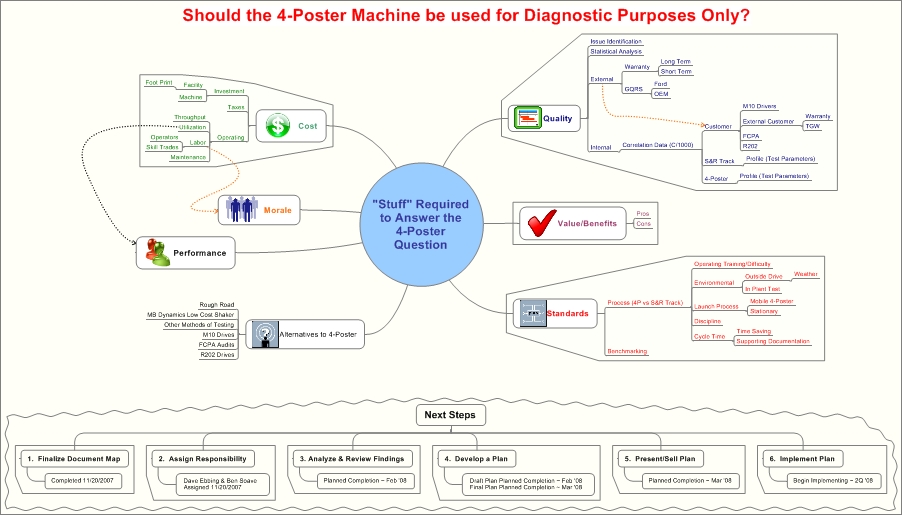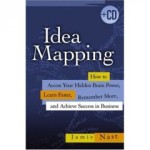An Idea Mapping Success Blogs Weblog
The 4-Poster Question – Today’s Feature in the Mindjet Newsletter
29Sep2008 Filed under: Group Idea Maps, Idea Mapping Example, Idea Mapping Workshops, Mind Mapping Examples Author: Jamie NastThis idea map (#120 within this blog) is featured in today’s Mindjet Monthly Newsletter with a little twist. Mindjet added a video clip of my description of this application to their newsletter. We filmed this in January when I was in San Francisco for the VizThink conference. Below is the linear description of today’s Idea Map.
The Plan for Answering the 4-Poster Question
The Chief Engineer of a large automotive company in southeastern Michigan and her team of 12 leaders were trying to answer the engineering question: “Should the 4-poster machine be used for diagnostic purposes only?”
A 4-poster machine is used to do random audit testing on vehicles. The issue was rather complex, and there were strong feelings on both the “yes” and “no” side of this question. These 13 leaders participated in a tailored 1-day version of the Idea Mapping Workshop. At the end of the day, the last hour was set aside to address the 4-poster question. Here is the process that was used:
1) Myself and two other seasoned idea mappers within the automotive company were the facilitators. The objective of this 1-hour activity was to identify ALL of the information they would need to answer the question (and create a plan to do so) rather than coming to a decision at this time.
2) After clarifying the objective, I gave them 5 minutes to create a map of every issue, question, needed research, or factors that would need to be addressed to answer the 4-poster question. This was done individually so that everyone’s ideas would be included in the final product.
3) Next we broke them into 3 groups. Their assignment was to build a group map that merged all of their thoughts from the individual idea maps. Where they had similar thoughts, they came to consensus on verbiage that would house their ideas. Any additional thoughts that emerged from the discussion were also added to the group map. Each group map was drawn on a flip chart. That took another 25 minutes.
4) We placed the 3 completed flip charts in the front of the room. MindManager was projected onto a screen for all to see. The next 20 minutes was dedicated to merging the information from all 3 flip charts into one MindManager map. That process continued until every detail was in the final map. Again where there were common themes, the group had healthy discussions about making sure they were describing issues in a way that everyone understood and agreed to.
5) The last 10 minutes were dedicated to defining their plan to see this project through to completion and next steps. This was also incorporated into the lower portion of the map.
So in just one hour this group was able to plan everything that needed to be done in order to have the data to answer the 4-poster question. They were pretty blown away and we were thrilled with the outcome.
Current Status: As of today the final decision has not yet been determined. The investigation is about 90% complete and there is buy-in from two additional organizations that are among those who would be impacted by this decision.
For detailed instructions and tips on this Team Idea Mapping Method and idea maps from 21 business professionals around the globe, get your copy of the Idea Mapping book from Amazon.
Idea Mapping Blog
The purpose of this blog is to share idea mapping examples and related learning from my Idea Mapping, Memory, Speed Reading, and Certification Workshops. This blog is dedicated to my Certified Idea Mapping Instructors, my clients, Mind Mapping and Idea Mapping practitioners around the globe.


![[Ask]](http://ideamapping.ideamappingsuccess.com/IdeaMappingBlogs/wp-content/plugins/bookmarkify/ask.png)
![[del.icio.us]](http://ideamapping.ideamappingsuccess.com/IdeaMappingBlogs/wp-content/plugins/bookmarkify/delicious.png)
![[Digg]](http://ideamapping.ideamappingsuccess.com/IdeaMappingBlogs/wp-content/plugins/bookmarkify/digg.png)
![[Facebook]](http://ideamapping.ideamappingsuccess.com/IdeaMappingBlogs/wp-content/plugins/bookmarkify/facebook.png)
![[Google]](http://ideamapping.ideamappingsuccess.com/IdeaMappingBlogs/wp-content/plugins/bookmarkify/google.png)
![[MySpace]](http://ideamapping.ideamappingsuccess.com/IdeaMappingBlogs/wp-content/plugins/bookmarkify/myspace.png)
![[Slashdot]](http://ideamapping.ideamappingsuccess.com/IdeaMappingBlogs/wp-content/plugins/bookmarkify/slashdot.png)
![[Sphinn]](http://ideamapping.ideamappingsuccess.com/IdeaMappingBlogs/wp-content/plugins/bookmarkify/sphinn.png)
![[StumbleUpon]](http://ideamapping.ideamappingsuccess.com/IdeaMappingBlogs/wp-content/plugins/bookmarkify/stumbleupon.png)
![[Technorati]](http://ideamapping.ideamappingsuccess.com/IdeaMappingBlogs/wp-content/plugins/bookmarkify/technorati.png)
![[ThisNext]](http://ideamapping.ideamappingsuccess.com/IdeaMappingBlogs/wp-content/plugins/bookmarkify/thisnext.png)
![[Twitter]](http://ideamapping.ideamappingsuccess.com/IdeaMappingBlogs/wp-content/plugins/bookmarkify/twitter.png)
![[Webride]](http://ideamapping.ideamappingsuccess.com/IdeaMappingBlogs/wp-content/plugins/bookmarkify/webride.png)
![[Email]](http://ideamapping.ideamappingsuccess.com/IdeaMappingBlogs/wp-content/plugins/bookmarkify/email.png)
Leave a reply